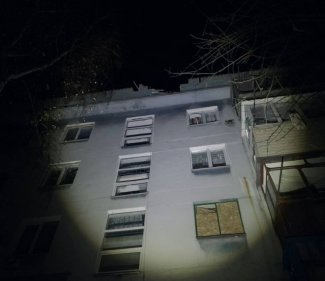Kyiv is on the threshold of blackout. 256th day of the war

The Ukrainian authorities warn that continued Russian destruction of energy infrastructure will lead to increasingly frequent blackouts. On 5 November, Kyiv mayor Vitali Klitschko said that the capital, now home to around 3 million people (350,000 are internally displaced), could run out of electricity, heating and water. He appealed to residents to consider moving outside temporarily to buildings with an independent heating source and water intake. A day later, mayoral officials did not rule out evacuating the city if there was a total loss of the power system. On the same day, President Volodymyr Zelensky declared that more than 4.5 million energy consumers – mainly in Kyiv and its surroundings – had been disconnected from power. On 7 November, planned and emergency power cuts began in seven oblasts – Kyiv, Chernihiv, Cherkasy, Zhytomyr, Sumy, Kharkiv and Poltava – and the capital from the morning.
The latest Russian missile and drone attacks have focused on energy and industrial infrastructure in cities on the back of Ukrainian defences. There was damage to facilities in the Dnipro, Zaporizhzhia and eastern Vilniansk, as well as Kramatorsk and Pokrovsk in the Donetsk Oblast. Both sides continued to shell and bombard enemy positions along the line of contact, with border regions of Chernihiv and Sumy oblasts also targeted by the invaders. According to Pentagon assessments, the Ukrainian army fired 4,000–7,000 artillery rounds daily, while the Russians fired nearly 20,000.
After a few days of reduced activity in the northeastern part of the Donetsk Oblast, aggressor forces have again increased the frequency of attacks. The defenders repulsed assaults on Bakhmut and the surrounding villages and the Russians’ subsequent attempts to break through towards Siversk and north of Horlivka. The Russians have not ceased their attacks north and west of Donetsk and south and east of Vuhledar. They have also made attempts to attack Ukrainian positions east of Lyman. There were also isolated attacks in the Kharkiv Oblast bordering the Russian Federation and south of Zaporizhzhia for the first time in many months. Ukrainian units, in turn, were to make further attempts to break through enemy positions on the border of the Kharkiv Oblast and north of Kherson. The Russians would continue to expand defensive positions in the Kherson Oblast on both sides of the Dnieper, on whose right bank they were to leave 20,000–25,000 troops.
The US announced another military support package for Ukraine. It is worth $400 million and will include 45 T-72 tanks from the Czech army’s inventory, 250 M1117 armoured cars, 40 armed cutters and 1,100 Phoenix Ghost drones. Ultimately, the Americans and the Dutch are to fund the refurbishment of 90 Czech T-72 tanks, the first 26 of which will arrive in the country in December. The Pentagon has created a Security Assistance Group of Ukraine (SAGU) to coordinate allied efforts to maintain appropriate levels of military assistance to Ukraine. It will be part of US Army European Command structure based in Wiesbaden.
Defence Minister Oleksii Reznikov gave notice of the creation of a three-tier system for the maintenance and overhaul of weapons and military equipment. The first level is maintenance work and simple repairs organised in military units in combat areas. The second is to be repairs of medium complexity carried out in the country. The third includes complex overhauls with component replacement (including electronics repair) to be carried out in Poland, the Czech Republic and Slovakia. Reznikov also announced the launch of the production of post-Soviet artillery ammunition of 122 mm and 152 mm calibres and 120 mm mortar grenades at the enterprises of state-owned Ukroboronprom. Tests of Ukrainian ammunition under combat conditions are currently underway, and full-scale production is expected to start within a few months. The minister appealed to Brazil to provide Kyiv with 35 mm ammunition for the German-donated Gepard anti-aircraft guns (Brazil produces them under a Swiss licence).
On 4 November, Vladimir Putin signed a law allowing the conscription of citizens convicted of most types of crime. The document sets out exceptions that exclude mobilisation (including treason, espionage and extremist activity). Putin asserted that 318,000 people had been conscripted into the army as part of ‘partial mobilisation’, 49,000 of whom are at the front. At the same time, the head of the so-called Wagner Group, Yevgeny Prigozhin, announced that volunteer training centres had been opened in the Kursk and Belgorod oblasts. He stressed that he was funding the venture with ‘his own money’, and suggested that business owners send 25% of their employees to volunteer service.
A day later, Dmitriy Berdnikov – in the past mayor of Yakutsk and Irkutsk – became the new head of the Mariupol occupation administration. According to Kyiv, the personnel changes are due to the occupation authorities’ internal scores. The city’s former head Konstantin Ivashchenko is suspected of embezzling funds transferred from Moscow. Mariupol is expected to have around 100,000 people deprived of regular electricity, gas and water supplies. According to Kyiv, the enemy has stepped up filtration activities in the occupied territories of the south of the country and is picking out those residents who are thought to support Ukrainian diversionary activities. Detainees are being taken to transit camps in Nova Kakhovka and Chaplynka (Kherson Oblast), where interrogations are being conducted to confirm their membership of the resistance.
Commentary
- Increasing disruptions to the supply of electricity, caused by the Russians’ systematic destruction of energy infrastructure, pose a huge challenge to the Ukrainian authorities. The threat of periodic and prolonged power cuts is becoming a test of the resilience of society and the civil defence system. The prospect of power, water and heating shortages is forcing those in power to consider ‘black scenarios’, including the evacuation of Kyiv residents. The authorities see it necessary to select localities less dependent on water or heating networks and equipped with sufficient power generators where residents of major cities can survive the winter. A renewed influx of refugees to EU countries also seems likely.
- The three-tier equipment maintenance and overhaul system announced by Reznikov is an attempt to formalise the practice that has taken shape in recent months. Ukraine’s arms industry has been largely destroyed, and attempts to restore it are hampered by the fact that the leading plants were located in cities now in the immediate hinterland of the war effort (Kharkiv, Dnipro, Kryvyi Rih, Mykolaiv, Zaporizhzhia). Problems have increasingly hampered the organisation of servicing and repair of armaments and military equipment in securing stable electricity supplies. While the system outlined by Reznikov, in which Kyiv’s allies would handle the most complex work, is based on a realistic assessment of the state’s current capabilities (there is most likely no plant in the country capable of carrying out complex repairs), Ukraine is unable to produce its own munitions. At the same time, it cannot be ruled out that lines for the final assembly of cartridges will be established from materials and components obtained from allies – especially Bulgaria, which is a potentate in NATO in the production of post-Soviet calibre ammunition (in recent days Sofia has decided to provide Kyiv with military support).




